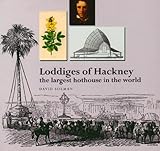 Conrad Loddiges (1738-1826) was born in the Kingdom of Hannover, now part of northern Germany, but after training in Holland, he moved at age 19 to the village of Hackney, now part of northeast London. He purchased a seed company, eventually turning this into Loddiges Nursery, one of the most prominent nurseries in Europe.
Conrad Loddiges (1738-1826) was born in the Kingdom of Hannover, now part of northern Germany, but after training in Holland, he moved at age 19 to the village of Hackney, now part of northeast London. He purchased a seed company, eventually turning this into Loddiges Nursery, one of the most prominent nurseries in Europe.
“Loddiges of Hackney” by David Solman is the history of that business. It was known for an array of large greenhouses, including a palm house 40 feet high that incorporated innovations such as steam heating and rain-like irrigation – allowing the raising of tropical palms, orchids, ferns, and carnivorous plants. A cooler, camellia house was created for this genus, allowing winter blooming. Sadly, none of these greenhouses have been preserved.
Outside, the nursery maintained a large planting of trees and shrubs. To this the term “arboretum” was first applied by a leading horticultural writer of the day. However, unlike the Washington Park Arboretum, this was a commercial venture, and these plants were displayed to promote sales. In the 1820s, Loddiges catalog had 2,664 hardy trees and shrubs, including roses and vines.
Loddiges Nursery was instrumental in providing live subjects for William Curtis and his Botanical Magazine. When Conrad’s son George Loddiges (1784-1846) began publishing in 1817 a nursery catalog in a similar format, known as The Botanical Cabinet, he hastened to assure Curtis’s successor as editor that this was not a rivalry. He wrote a conciliatory note observing “the boundless variety of the vegetable world is doubtless sufficient to afford subjects for us all.”
Reviewed by: Brian Thompson on February 23, 2024
Excerpted from the Spring 2024 issue of the Arboretum Bulletin